Seismic Fragility Assessment of an Existing Multi-Span RC Bridge Equipped with Risk Mitigation Systems
Abstract
1. Introduction
2. Selection of Benchmark Bridge
3. Verification of Numerical Modeling before and after Retrofit
4. Three Dimensional Fiber-Based Modeling of Benchmark Bridge
5. Performance Assessment of As-Built Bridge
5.1. Dynamic Characteristics
5.2. Bridge Lateral Capacity
5.3. Assessment of Seismic Response
6. Probabilistic Assessment of As-Built Bridge
- The performance limit states of the benchmark bridge and the ground motion intensity measure are defined.
- The seismic response of the benchmark bridge obtained from IDA using 14 input ground motions representing two seismic scenarios is used to perform nonlinear regression analyses.
- The demand, capacity, and modeling uncertainties are accounted for, as previously discussed.
- A lognormal cumulative distribution function is used to generate the fragility relationship.
- The limit state exceedance probabilities for each performance limit state are estimated from the fragility functions.
- For the probabilistic risk assessment of the bridge inventory represented by the benchmark structure using risk assessment platforms, the vulnerability curves can be derived by integrating the economic losses with the fragility functions. In this study, the vulnerability assessment of the benchmark bridge is represented by the fragility relationships only. Additional information regarding the seismic fragility analysis and the vulnerability assessment of structures are available elsewhere [2,36,53,54].
7. Assessment of the Lateral Capacity of Retrofitted Bridge
8. Probabilistic Seismic Performance Assessment of Retrofit Techniques
9. Summary and Conclusions
- The developed fiber-based models of the existing bridge bent before and after the retrofit with BRBs provided a similar response to previous experimental studies and enabled using this modeling approach for idealizing the as-built benchmark bridge and the retrofitted structure with mitigation approaches.
- The pushover analysis results provided insights into the local damage in the bents in the two orthogonal directions of the as-built bridge, which was more significant in the transverse direction than in the longitudinal counterpart. In the former direction, plastic hinges were detected at the bottom critical regions of columns, followed by the upper critical segments. Afterward, yielding spread upwards to half the piers height. The lateral strength and overstrength factors calculated using IPA were improved after retrofitting the as-built bridge with different BRBs and were comparable to those reported in previous studies for entire bridges.
- The derived fragility curves for the as-built benchmark bridge indicated higher CD LSEPs in bridge bents under far-field events compared to their near-source ground motions. High BD LSEPs were also detected in the transverse direction under far-field events and in the longitudinal direction under near-source ground motions, particularly for the SL and MO performance limit states. The observed vulnerability of the benchmark bridge reflected the pressing need for mitigation techniques to reduce the expected seismic losses under different seismic scenarios.
- The adopted BRB and SC-BRB retrofit alternatives for the benchmark bridge were effective mitigation measures in reducing CD demands and LSEPs under both considered seismic scenarios, particularly the far-field earthquakes that have a high impact on civil engineering structures in the study area. While these retrofit alternatives proved to have minor impacts on BDs, additional retrofit alternatives are recommended to be combined with the adopted mitigation measures in this study to control both the CD and BD demands of pre-seismic code multi-span simply supported bridges.
Author Contributions
Funding
Institutional Review Board Statement
Informed Consent Statement
Data Availability Statement
Acknowledgments
Conflicts of Interest
Abbreviations
| 3DFB | three-dimensional fiber-based |
| BD | bearing displacement |
| BRBs | buckling restrained braces |
| BRB1 | sacrificial buckling restrained brace |
| BRB1 | non-sacrificial buckling restrained brace |
| CD | curvature ductility |
| CO | complete limit state performance level/limit state |
| CSM | capacity spectrum method |
| DM | damage measure |
| ERHA | elastic response history analysis |
| EX | extensive performance level/limit state |
| IDAs | incremental dynamic analyses |
| IM | intensity measure |
| IPAs | inelastic pushover analyses |
| IRHA | inelastic response history analysis |
| LSEPs | limit state exceedance probabilities |
| MO | moderate performance level/limit state |
| PGA | peak ground acceleration |
| RC | reinforced concrete |
| SC-BRBs | self-centering buckling restrained braces |
| SL | slight performance level/limit state |
References
- Elnashai, A.S.; Mwafy, A.M. Seismic response and design. In ICE Manual of Bridge Engineering, 3rd ed.; Parke, G., Hewson, N., Eds.; Thomas Telford Ltd., Institution of Civil Engineers: London, UK, 2022. [Google Scholar]
- Elnashai, A.S.; Di Sarno, L. Fundamentals of Earthquake Engineering: From Source to Fragility, 2nd ed.; John Wiley & Sons, Ltd: West Sussex, UK, 2015; p. 347. [Google Scholar]
- Elnashai, A.S.; Gencturk, B.; Kwon, O.-S.; Al-Qadi, I.L.; Hashash, Y.; Roesler, J.R.; Kim, S.J.; Jeong, S.-H.; Dukes, J.; Valdivia, A. The Maule (Chile) Earthquake of February 27, 2010: Consequence Assessment and Case Studies; MAE Center Report No. 10-04; Mid-America Earthquake Center, University of Illinois at Urbana-Champaign: Urbana, IL, USA, 2010. [Google Scholar]
- Mwafy, A.M. Earthquake Risk Management Systems and Their Applications for Building Seismic-Resilient Communities. In Resilient Structures and Infrastructure; Springer: Berlin/Heidelberg, Germany, 2019; pp. 129–157. [Google Scholar]
- Hashash, Y.M.; Mwafy, A.; Elnashai, A.S.; Hajjar, J.F. Development of a multi-disciplinary graduate course on consequence-based earthquake risk management. Int. J. Contin. Eng. Educ. Life Long Learn. 2012, 22, 127–147. [Google Scholar] [CrossRef]
- Kircher, C.A.; Whitman, R.V.; Holmes, W.T. HAZUS earthquake loss estimation methods. Nat. Hazards Rev. 2006, 7, 45–59. [Google Scholar] [CrossRef]
- Kwon, O.-S.; Mwafy, A.M.; Elnashai, A.S. Analytical Assessment of Seismic Performance Evaluation Procedures for Bridges. In Proceedings of the ACI Fall 2008 Convention, St. Louis, MO, USA, 2–6 November 2008; ACI Special Publication: St. Louis, MO, USA, 2010; pp. 45–61. [Google Scholar]
- FHWA. Seismic Retrofitting Manual for Highway Structures: Part 1—Bridges; Report No. FHWA-HRT-06-032; U.S. Department of Transportation: Washington, DC, USA, 2006. [Google Scholar]
- Movaghati, S.; Abdelnaby, A.E. Advancements in fragility analysis using numerical calibration methods for a horizontally curved RC bridge. Eng. Struct. 2016, 125, 236–243. [Google Scholar] [CrossRef]
- Kwon, O.-S.; Jeong, S.-H. Seismic displacement demands on skewed bridge decks supported on elastomeric bearings. J. Earthq. Eng. 2013, 17, 998–1022. [Google Scholar] [CrossRef]
- Nielson, B.G.; DesRoches, R. Seismic fragility methodology for highway bridges. In Proceedings of the Structures Congress 2006: Structural Engineering and Public Safety, St. Louis, MO, USA, 18–21 May 2006; pp. 1–9. [Google Scholar]
- Muntasir Billah, A.H.M.; Alam, M.S. Seismic fragility assessment of highway bridges: A state-of-the-art review. Struct. Infrastruct. Eng. 2015, 11, 804–832. [Google Scholar] [CrossRef]
- Mangalathu, S.; Heo, G.; Jeon, J.-S. Artificial neural network based multi-dimensional fragility development of skewed concrete bridge classes. Eng. Struct. 2018, 162, 166–176. [Google Scholar] [CrossRef]
- Xie, Y.; Ebad Sichani, M.; Padgett, J.E.; DesRoches, R. The promise of implementing machine learning in earthquake engineering: A state-of-the-art review. Earthq. Spectra 2020, 36, 1769–1801. [Google Scholar] [CrossRef]
- Harirchian, E.; Hosseini, S.E.A.; Jadhav, K.; Kumari, V.; Rasulzade, S.; Işık, E.; Wasif, M.; Lahmer, T. A review on application of soft computing techniques for the rapid visual safety evaluation and damage classification of existing buildings. J. Build. Eng. 2021, 43, 102536. [Google Scholar] [CrossRef]
- Valentijn, T.; Margutti, J.; van den Homberg, M.; Laaksonen, J. Multi-hazard and spatial transferability of a cnn for automated building damage assessment. Remote Sens. 2020, 12, 2839. [Google Scholar] [CrossRef]
- Harirchian, E.; Lahmer, T. Improved rapid assessment of earthquake hazard safety of structures via artificial neural networks. IOP Conf. Ser. Mater. Sci. Eng. 2020, 897, 012014. [Google Scholar] [CrossRef]
- Crespi, P.; Zucca, M.; Valente, M. On the collapse evaluation of existing RC bridges exposed to corrosion under horizontal loads. Eng. Fail. Anal. 2020, 116, 104727. [Google Scholar] [CrossRef]
- Wei, B.; Hu, Z.; He, X.; Jiang, L. Evaluation of optimal ground motion intensity measures and seismic fragility analysis of a multi-pylon cable-stayed bridge with super-high piers in Mountainous Areas. Soil Dyn. Earthq. Eng. 2020, 129, 105945. [Google Scholar] [CrossRef]
- Zhao, Y.; Hu, H.; Bai, L.; Tang, M.; Chen, H.; Su, D. Fragility analyses of bridge structures using the logarithmic piecewise function-based probabilistic seismic demand model. Sustainability 2021, 13, 7814. [Google Scholar] [CrossRef]
- Carden, L.P.; Itani, A.M.; Buckle, I.G. Seismic performance of steel girder bridges with ductile cross frames using buckling-restrained braces. J. Struct. Eng. 2006, 132, 338–345. [Google Scholar] [CrossRef]
- Wang, Y.; Ibarra, L.; Pantelides, C. Collapse capacity of reinforced concrete skewed bridges retrofitted with buckling-restrained braces. Eng. Struct. 2019, 184, 99–114. [Google Scholar] [CrossRef]
- Bazaez, R.; Dusicka, P. Performance assessment of multi-column RC bridge bents seismically retrofitted with buckling-restrained braces. Bull. Earthq. Eng. 2018, 16, 2135–2160. [Google Scholar] [CrossRef]
- Chou, C.-C.; Tsai, W.-J.; Chung, P.-T. Development and validation tests of a dual-core self-centering sandwiched buckling-restrained brace (SC-SBRB) for seismic resistance. Eng. Struct. 2016, 121, 30–41. [Google Scholar] [CrossRef]
- Wang, H.; Nie, X.; Pan, P. Development of a self-centering buckling restrained brace using cross-anchored pre-stressed steel strands. J. Constr. Steel Res. 2017, 138, 621–632. [Google Scholar] [CrossRef]
- Dong, H.; Du, X.; Han, Q.; Hao, H.; Bi, K.; Wang, X. Performance of an innovative self-centering buckling restrained brace for mitigating seismic responses of bridge structures with double-column piers. Eng. Struct. 2017, 148, 47–62. [Google Scholar] [CrossRef]
- Xiang, N.; Alam, M.S. Displacement-based seismic design of bridge bents retrofitted with various bracing devices and their seismic fragility assessment under near-fault and far-field ground motions. Soil Dyn. Earthq. Eng. 2019, 119, 75–90. [Google Scholar] [CrossRef]
- ICBO. Uniform Building Code, 1997 Edition; ICBO: Lansing, MI, USA, 1997. [Google Scholar]
- Shama, A.A. Site specific probabilistic seismic hazard analysis at Dubai Creek on the west coast of UAE. Earthq. Eng. Eng. Vib. 2011, 10, 143–152. [Google Scholar] [CrossRef]
- Abdalla, J.A.; Al-Homoud, A.S. Seismic hazard assessment of United Arab Emirates and its surroundings. J. Earthq. Eng. 2004, 8, 817–837. [Google Scholar] [CrossRef]
- Mwafy, A.M.; Elnashai, A.S.; Sigbjörnsson, R.; Salama, A. Significance of severe distant and moderate close earthquakes on design and behavior of tall buildings. Struct. Des. Tall Spec. Build. 2006, 15, 391–416. [Google Scholar] [CrossRef]
- Yagoub, M.; Al Yammahi, A.A. Spatial distribution of natural hazards and their proximity to heritage sites: Case of the United Arab Emirates. Int. J. Disaster Risk Reduct. 2022, 71, 102827. [Google Scholar] [CrossRef]
- Sawires, R.; Peláez, J.A.; AlHamaydeh, M.; Henares, J. A state-of-the-art seismic source model for the United Arab Emirates. J. Asian Earth Sci. 2019, 186, 104063. [Google Scholar] [CrossRef]
- Anzlin, A.; Fischinger, M.; Isakovic, T. Cyclic response of I-shaped bridge columns with substandard transverse reinforcement. Eng. Struct. 2015, 99, 642–652. [Google Scholar] [CrossRef]
- Mwafy, A.M.; Khalifa, S. Effect of vertical structural irregularity on seismic design of tall buildings. Struct. Des. Tall Spec. Build. 2017, 26, e1399. [Google Scholar] [CrossRef]
- Alwaeli, W.; Mwafy, A.M.; Pilakoutas, K.; Guadagnini, M. Rigorous versus less-demanding fragility relations for RC high-rise buildings. Bull. Earthq. Eng. 2020, 18, 5885–5918. [Google Scholar] [CrossRef]
- Mwafy, A.M.; AlMorad, B. Verification of performance criteria using shake table testing for the vulnerability assessment of reinforced concrete buildings. Struct. Des. Tall Spec. Build. 2019, 28, e1601. [Google Scholar] [CrossRef]
- Alwaeli, W.; Mwafy, A.M.; Pilakoutas, K.; Guadagnini, M. Multi-level nonlinear modeling verification scheme of RC high-rise wall buildings. Bull. Earthq. Eng. 2017, 15, 2035–2053. [Google Scholar] [CrossRef]
- Bazaez, R.; Dusicka, P. Cyclic behavior of reinforced concrete bridge bent retrofitted with buckling restrained braces. Eng. Struct. 2016, 119, 34–48. [Google Scholar] [CrossRef]
- Seismosoft SeismoStruct 2022—A Computer Program for Static and Dynamic Nonlinear Analysis of Framed Structures. 2022. Available online: https://seismosoft.com/ (accessed on 1 July 2022).
- Bazaez, R.; Dusicka, P. Cyclic loading for RC bridge columns considering subduction megathrust earthquakes. J. Bridge Eng. 2016, 21, 04016009. [Google Scholar] [CrossRef]
- Shamsabadi, A.; Rollins, K.M.; Kapuskar, M. Nonlinear soil-abutment-bridge structure interaction for seismic performance-based design. J. Geotech. Geoenviron. Eng. 2007, 133, 707–720. [Google Scholar] [CrossRef]
- Caltrans. Seismic Design Criteria; State of California, Department of Transportation: Sacramento, CA, USA, 2019. [Google Scholar]
- Park, R. Evaluation of ductility of structures and structural assemblages from laboratory testing. Bull. N. Z. Soc. Earthq. Eng. 1989, 22, 155–166. [Google Scholar] [CrossRef]
- Mwafy, A.M.; Kwon, O.-S.; Elnashai, A.S. Seismic assessment of an existing non-seismically designed major bridge-abutment-foundation system. Eng. Struct. 2010, 32, 2192–2209. [Google Scholar] [CrossRef]
- Muthukumar, S.; DesRoches, R. A Hertz contact model with non-linear damping for pounding simulation. Earthq. Eng. Struct. Dyn. 2006, 35, 811–828. [Google Scholar] [CrossRef]
- Buckle, I.; Nagarajaiah, S.; Ferrell, K. Stability of elastomeric isolation bearings: Experimental study. J. Struct. Eng. 2002, 128, 3–11. [Google Scholar] [CrossRef]
- Priestley, M.J.N.; Seible, F.; Calvi, G.M. Seismic Design and Retrofit of Bridges; John Wiley & Sons: New York, NY, USA, 1996. [Google Scholar]
- Alwaeli, W.; Mwafy, A.M.; Pilakoutas, K.; Guadagnini, M. A methodology for defining seismic scenario-structure-based limit state criteria for RC high-rise wall buildings using net drift. Earthq. Eng. Struct. Dyn. 2017, 46, 1325–1344. [Google Scholar] [CrossRef]
- Kabir, M.R.; Billah, A.M.; Alam, M.S. Seismic fragility assessment of a multi-span RC bridge in Bangladesh considering near-fault, far-field and long duration ground motions. Structures 2019, 19, 333–348. [Google Scholar] [CrossRef]
- Kwon, O.-S.; Elnashai, A.S. The effect of material and ground motion uncertainty on the seismic vulnerability curves of RC structure. Eng. Struct. 2006, 28, 289–303. [Google Scholar] [CrossRef]
- Wen, Y.; Ellingwood, B.R.; Bracci, J.M. Vulnerability Function Framework for Consequence-Based Engineering; MAE Center Project DS-4 Report; University of Illinois at Urbana-Champaign: Urbana, IL, USA, 2004. [Google Scholar]
- Wen, Y.K.; Ellingwood, B.R. The role of fragility assessment in consequence-based engineering. Earthq. Spectra 2005, 21, 861–877. [Google Scholar] [CrossRef]
- Mwafy, A.M.; Elkholy, S. Performance assessment and prioritization of mitigation approaches for pre-seismic code structures. Adv. Struct. Eng. 2017, 20, 917–939. [Google Scholar] [CrossRef]
- Wu, W.; Li, L.; Shao, X. Seismic assessment of medium-span concrete cable-stayed bridges using the component and system fragility functions. J. Bridge Eng. 2016, 21, 04016027. [Google Scholar] [CrossRef]
- Dong, H.; Du, X.; Han, Q.; Bi, K.; Hao, H. Hysteretic performance of RC double-column bridge piers with self-centering buckling-restrained braces. Bull. Earthq. Eng. 2019, 17, 3255–3281. [Google Scholar] [CrossRef]
- FHWA. LRFD Seismic Analysis and Design of Bridges: Reference Manual; FHWA-NHI-15-004; Federal Highway Administration: Washington, DC, USA, 2014. [Google Scholar]
- Ghee, A.B.; Priestley, M.N.; Paulay, T. Seismic shear strength of circular reinforced concrete columns. Struct. J. 1989, 86, 45–59. [Google Scholar]
- Kappos, A.J.; Paraskeva, T.S.; Moschonas, I.F. Response modification factors for concrete bridges in Europe. J. Bridge Eng. 2013, 18, 1328–1335. [Google Scholar] [CrossRef][Green Version]
- Sánchez, A.R.; Arêde, A.; Jara, J.M.; Delgado, P. Overstrength factors of RC bridges supported on single and multi-column RC piers in Mexico. Earthq. Eng. Struct. Dyn. 2021, 50, 3695–3712. [Google Scholar] [CrossRef]

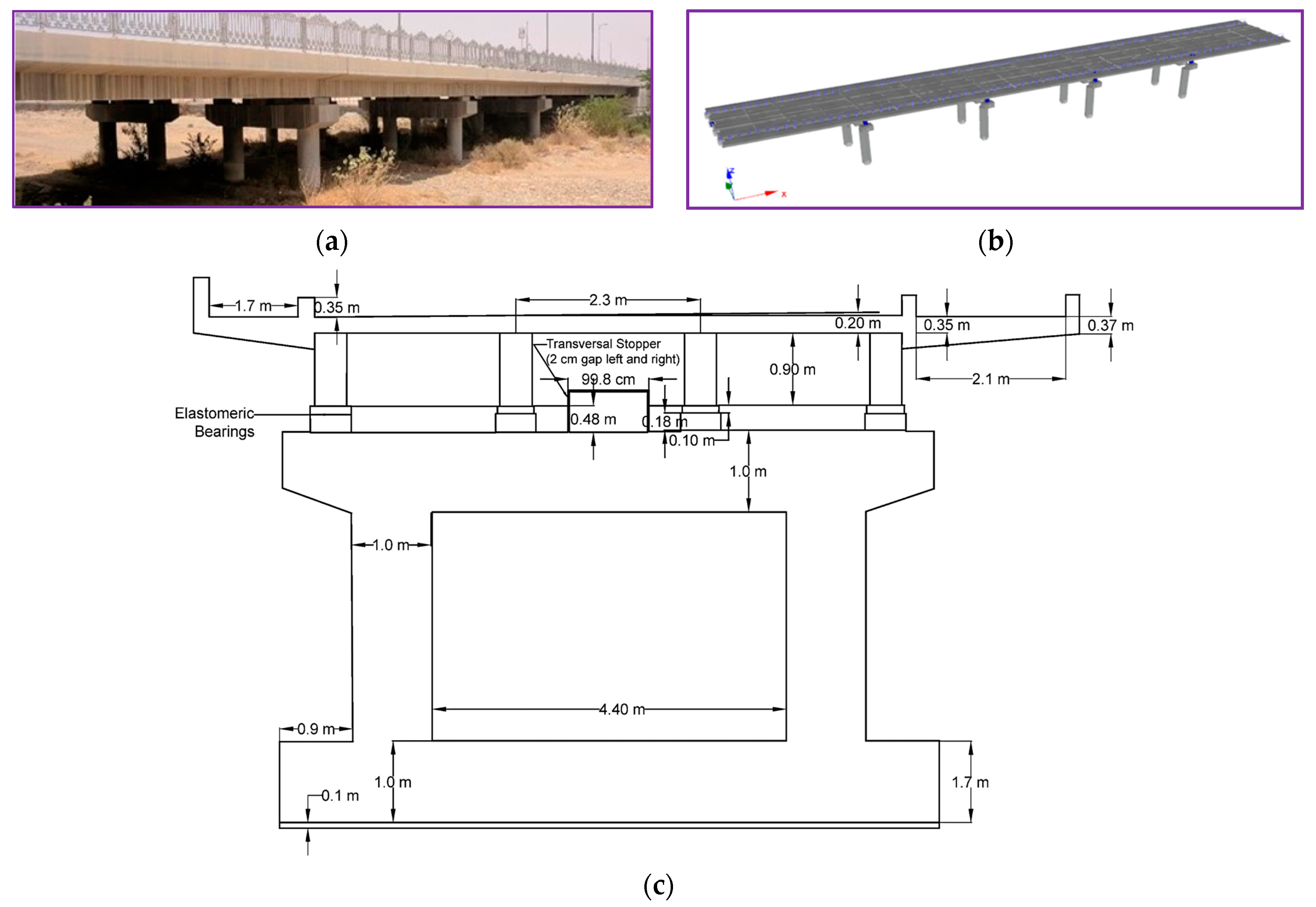
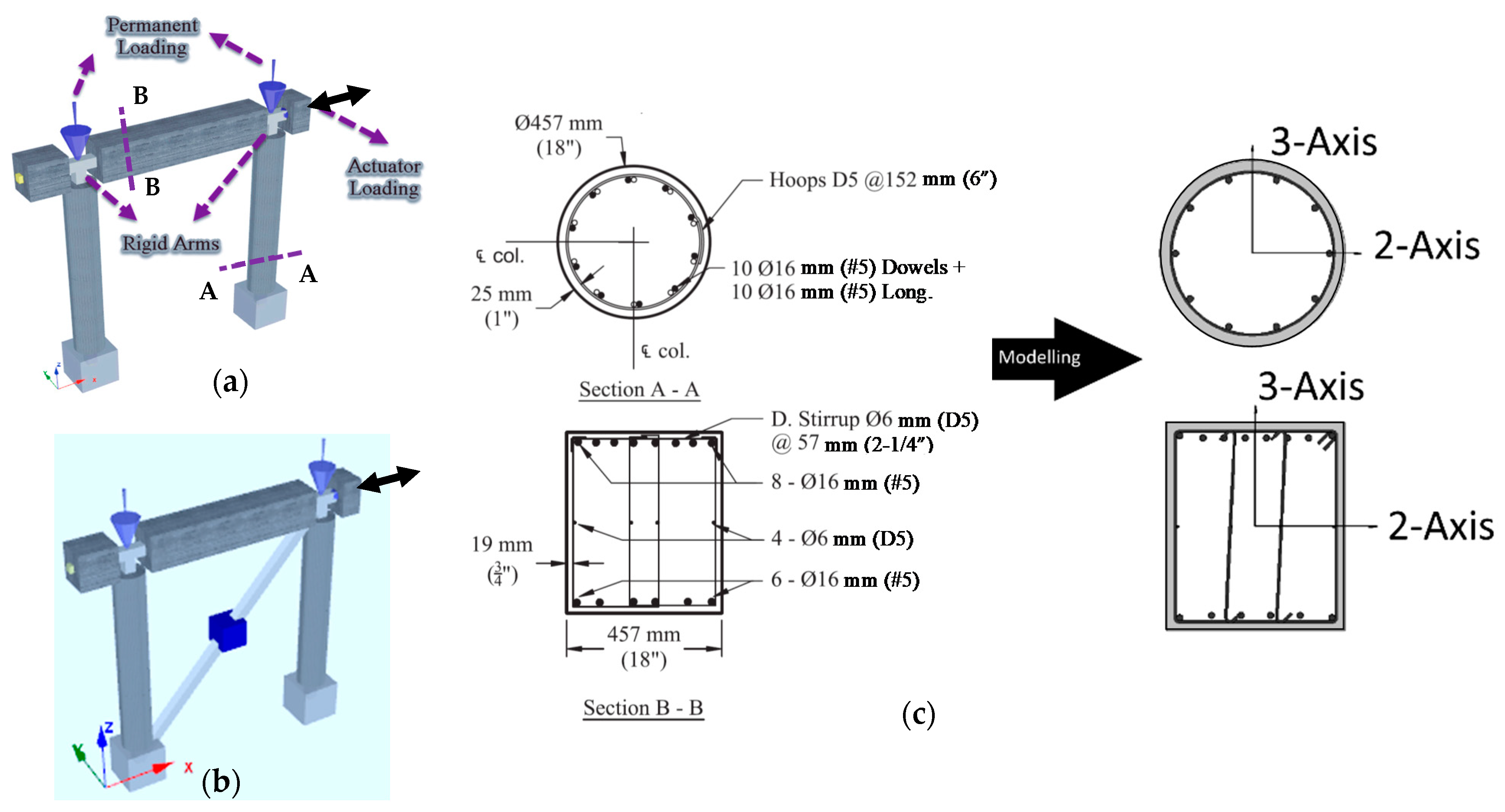
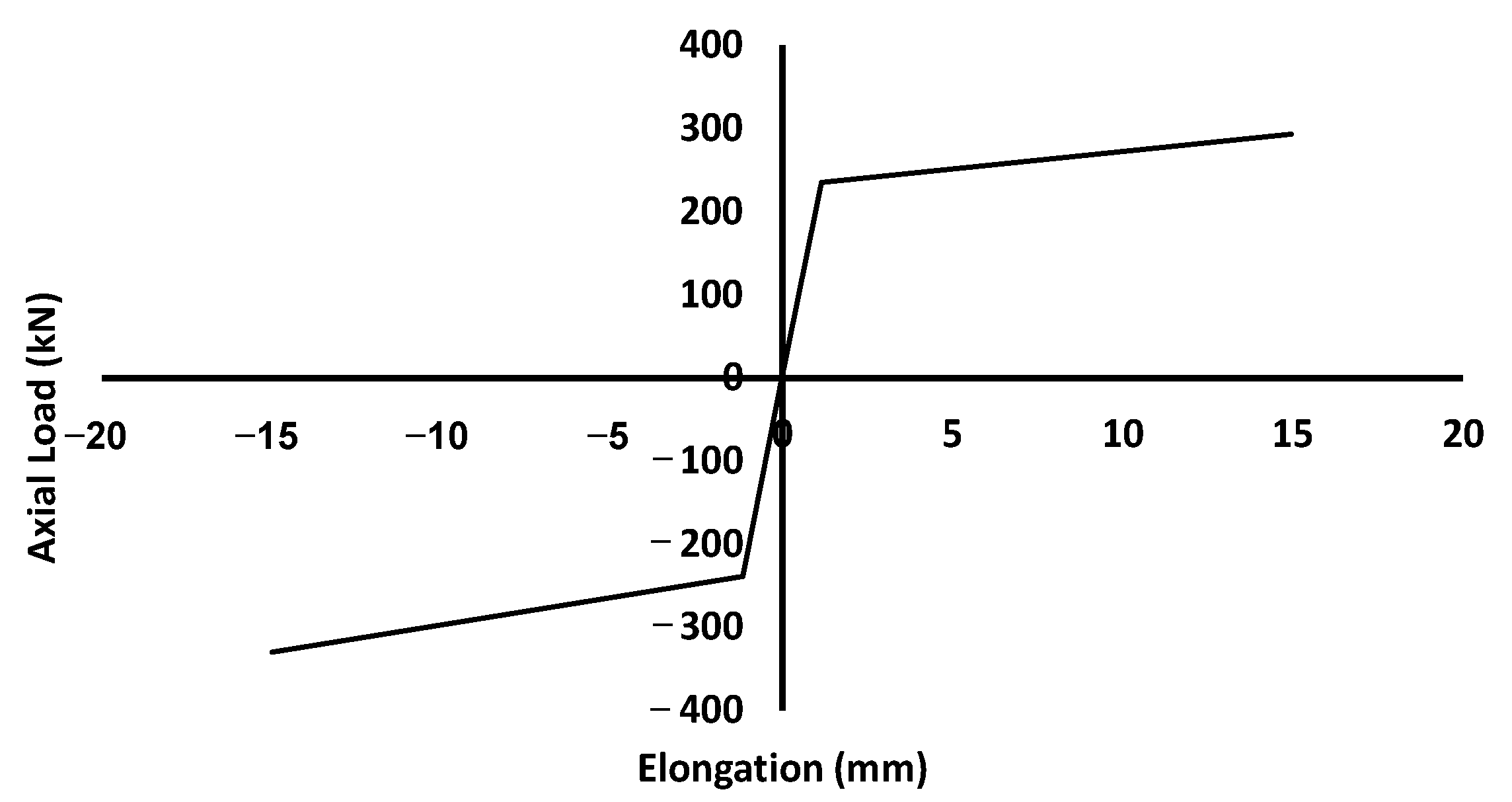
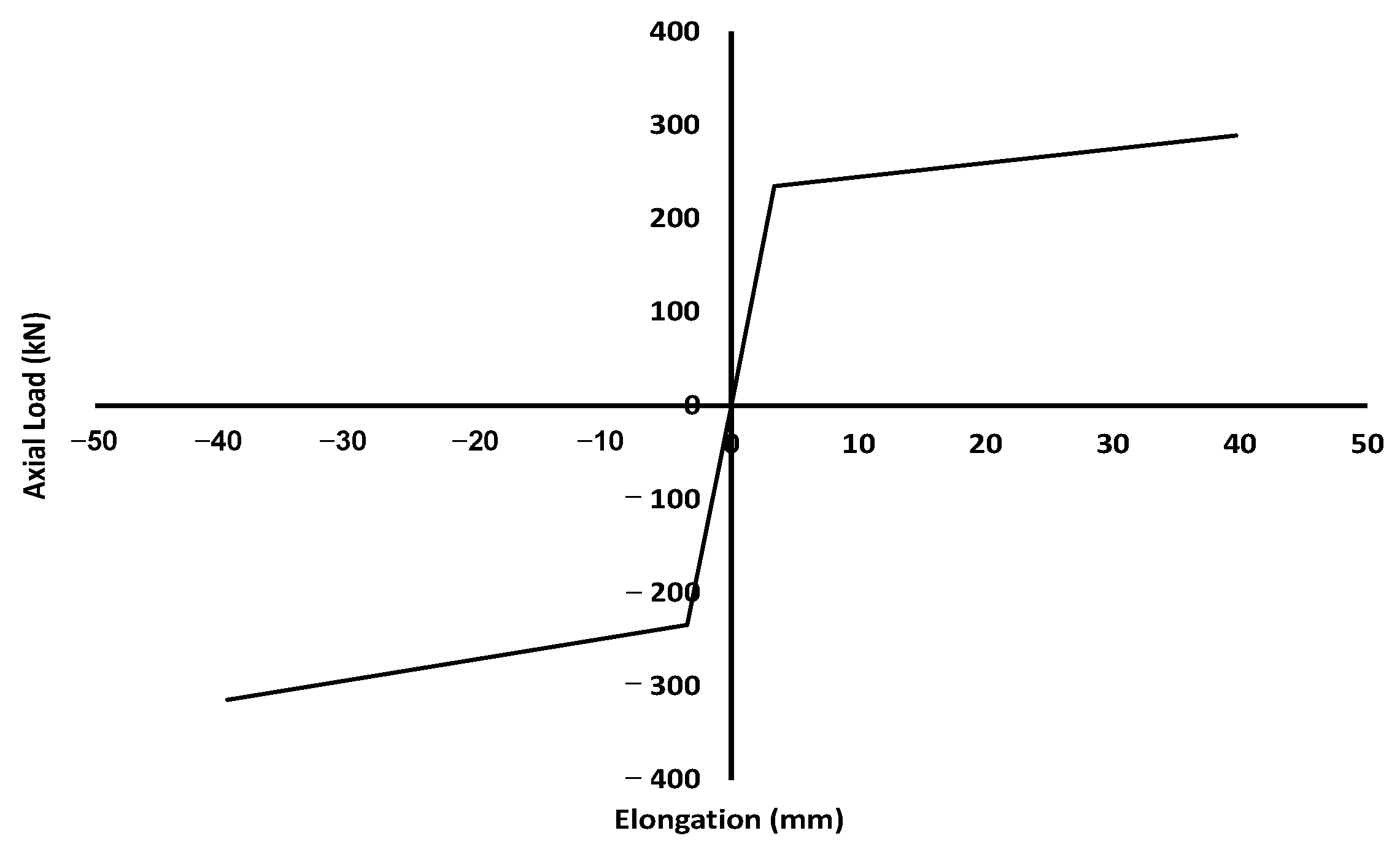



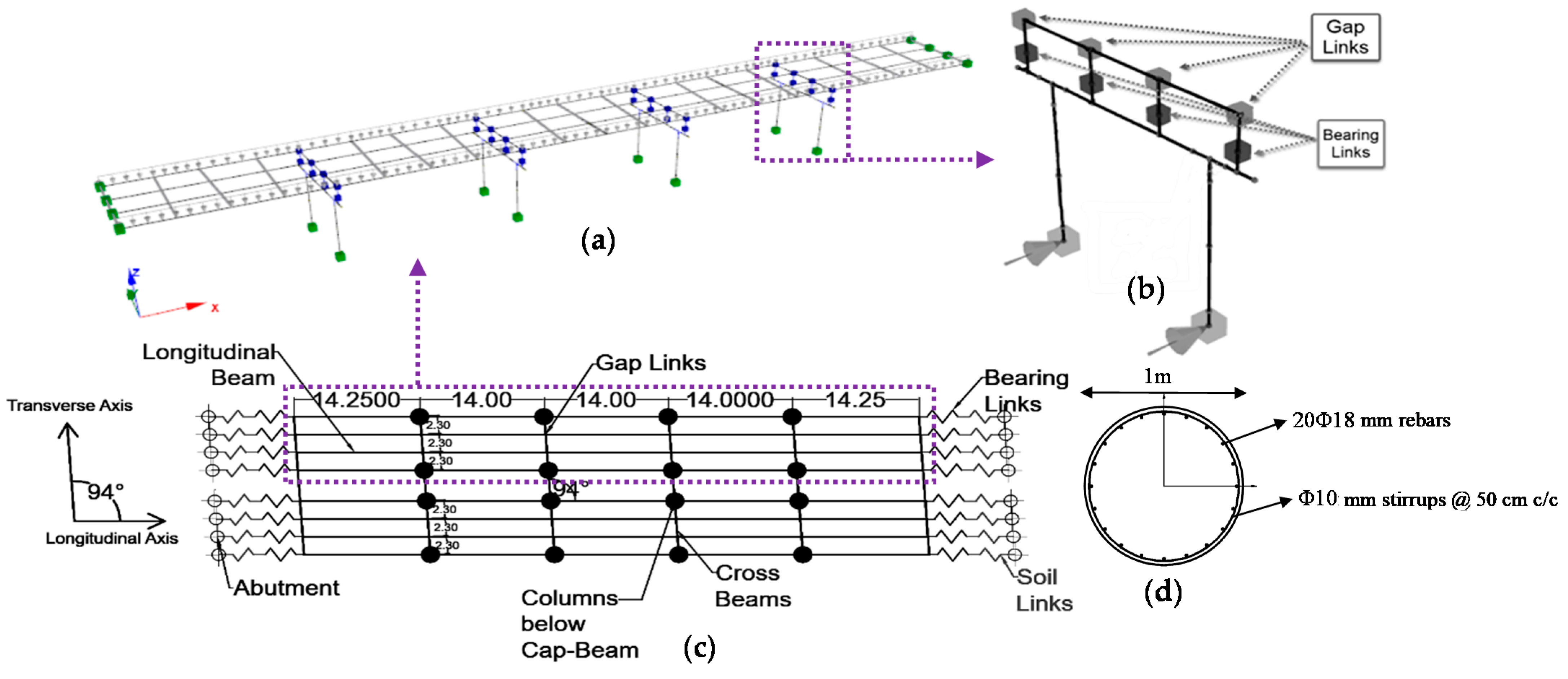


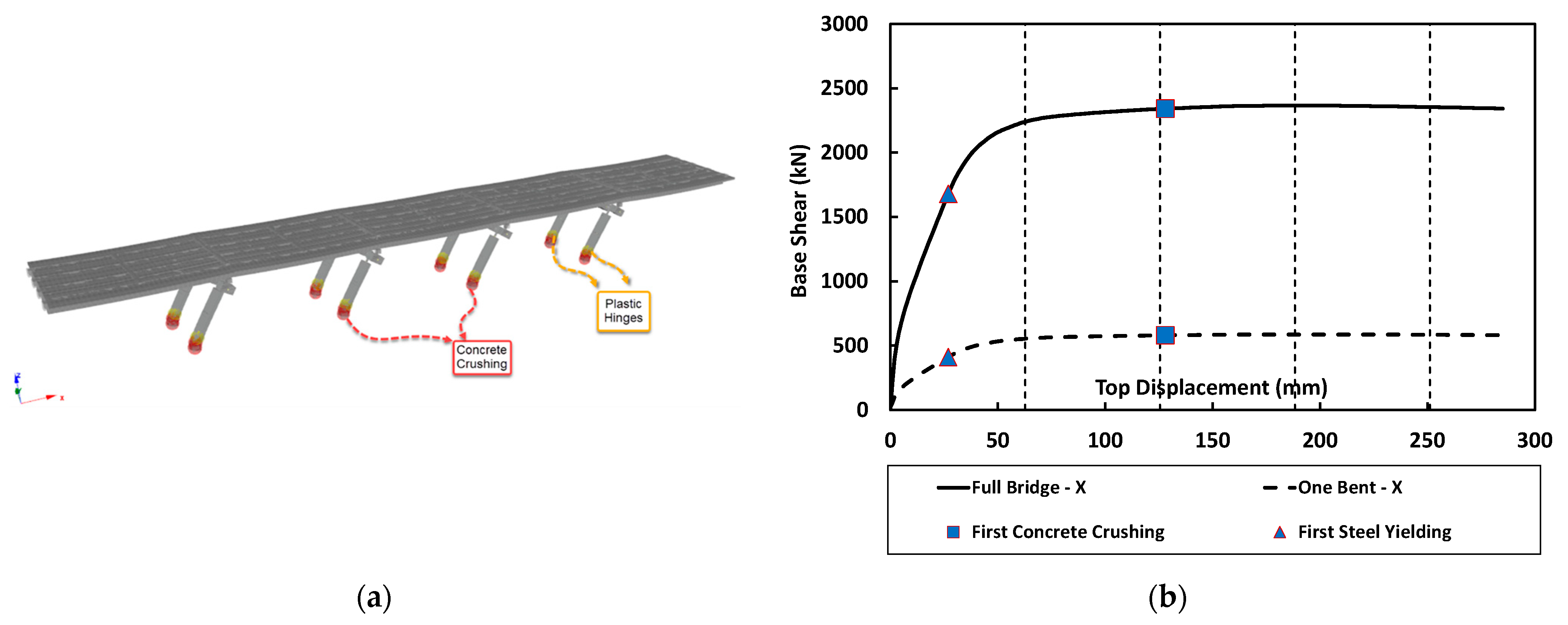
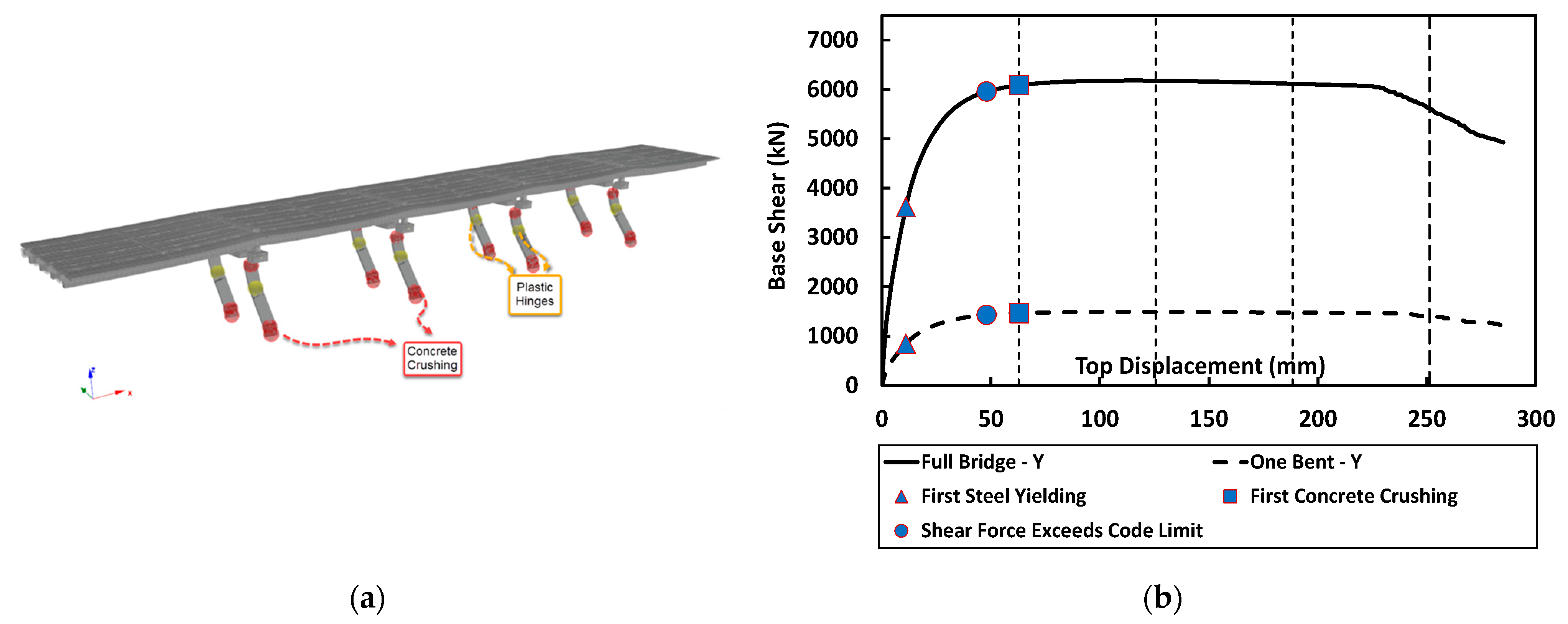
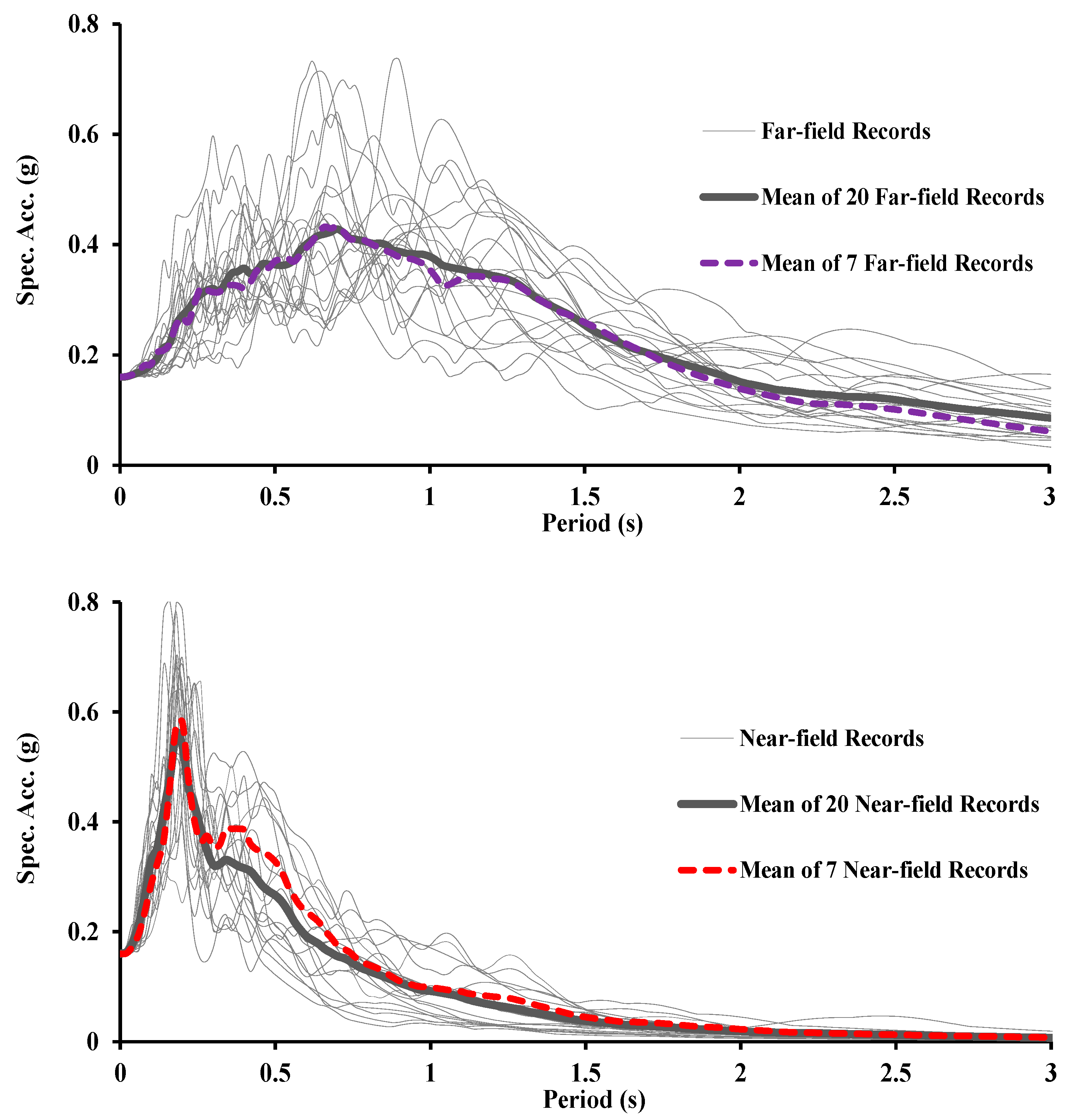
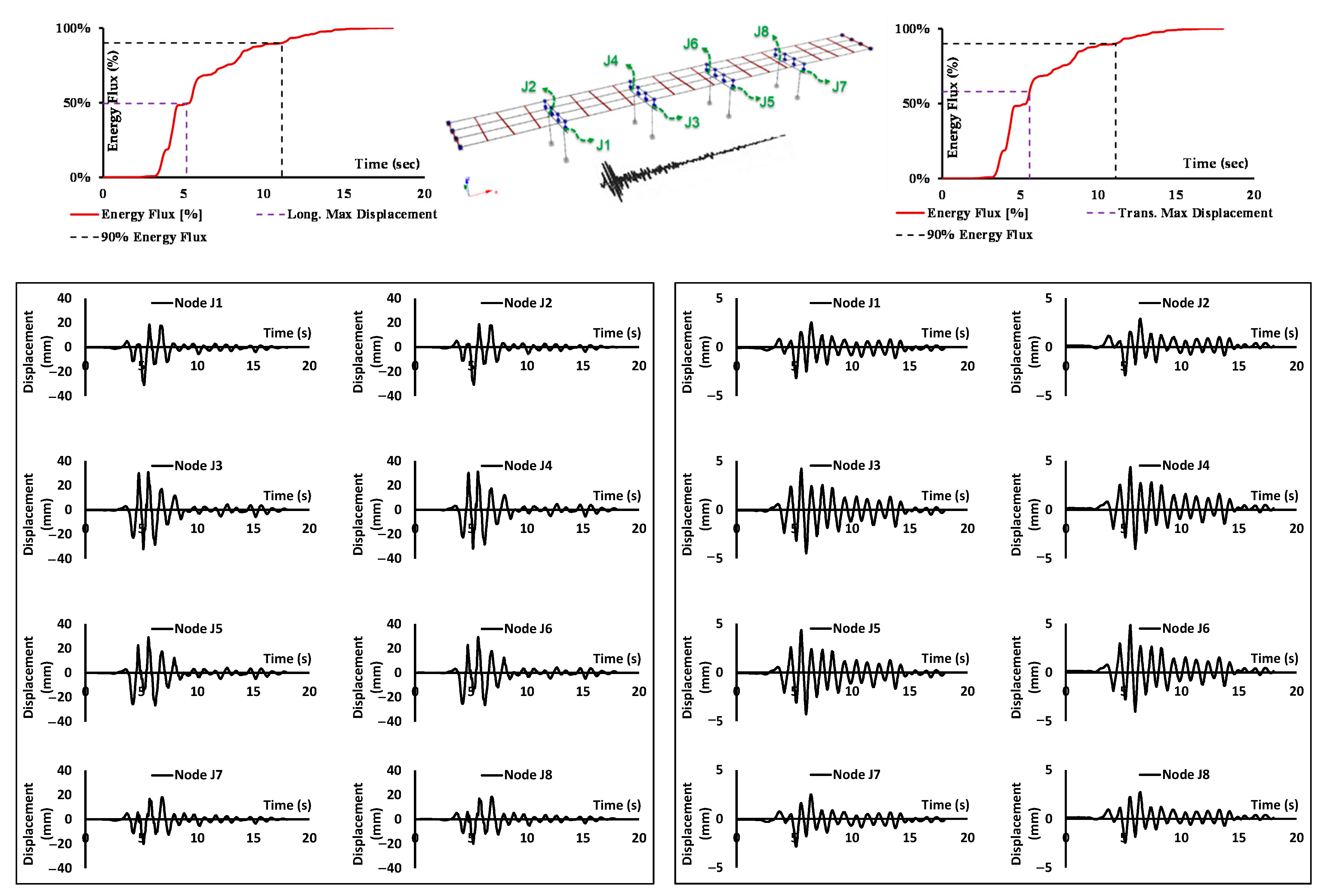
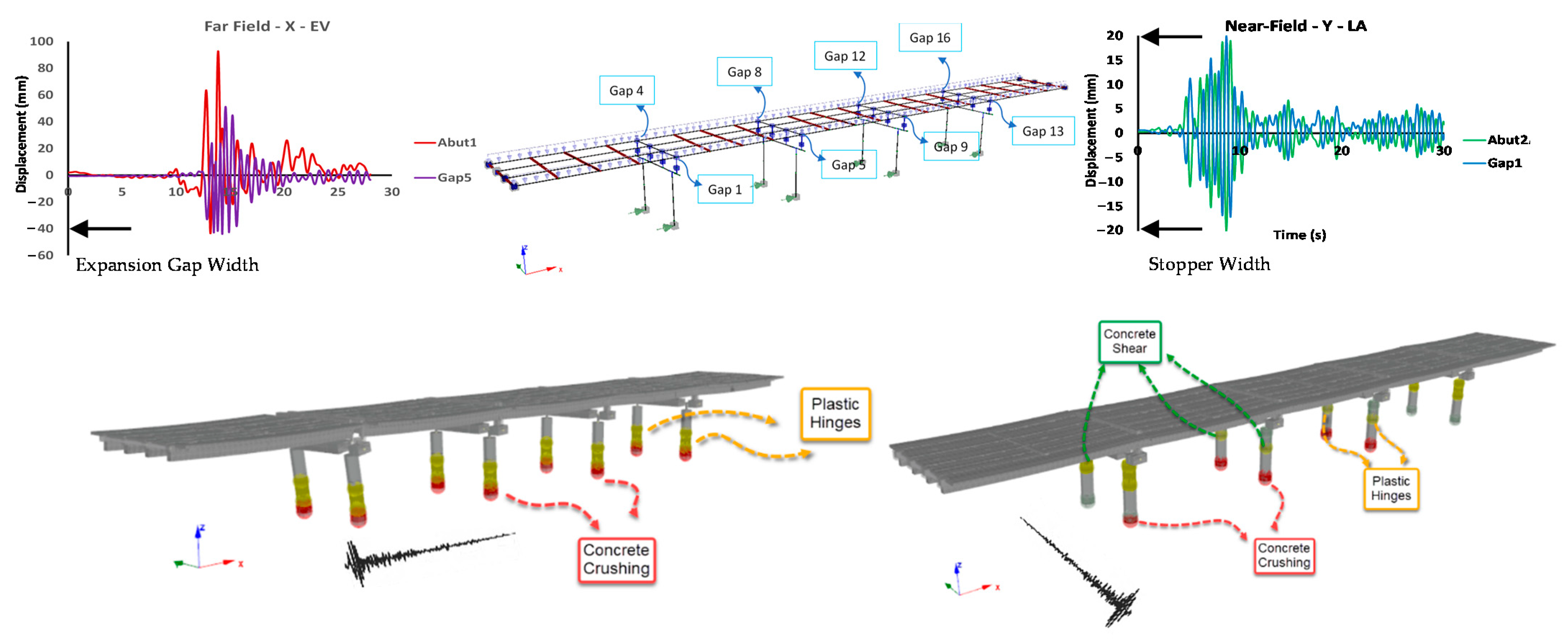
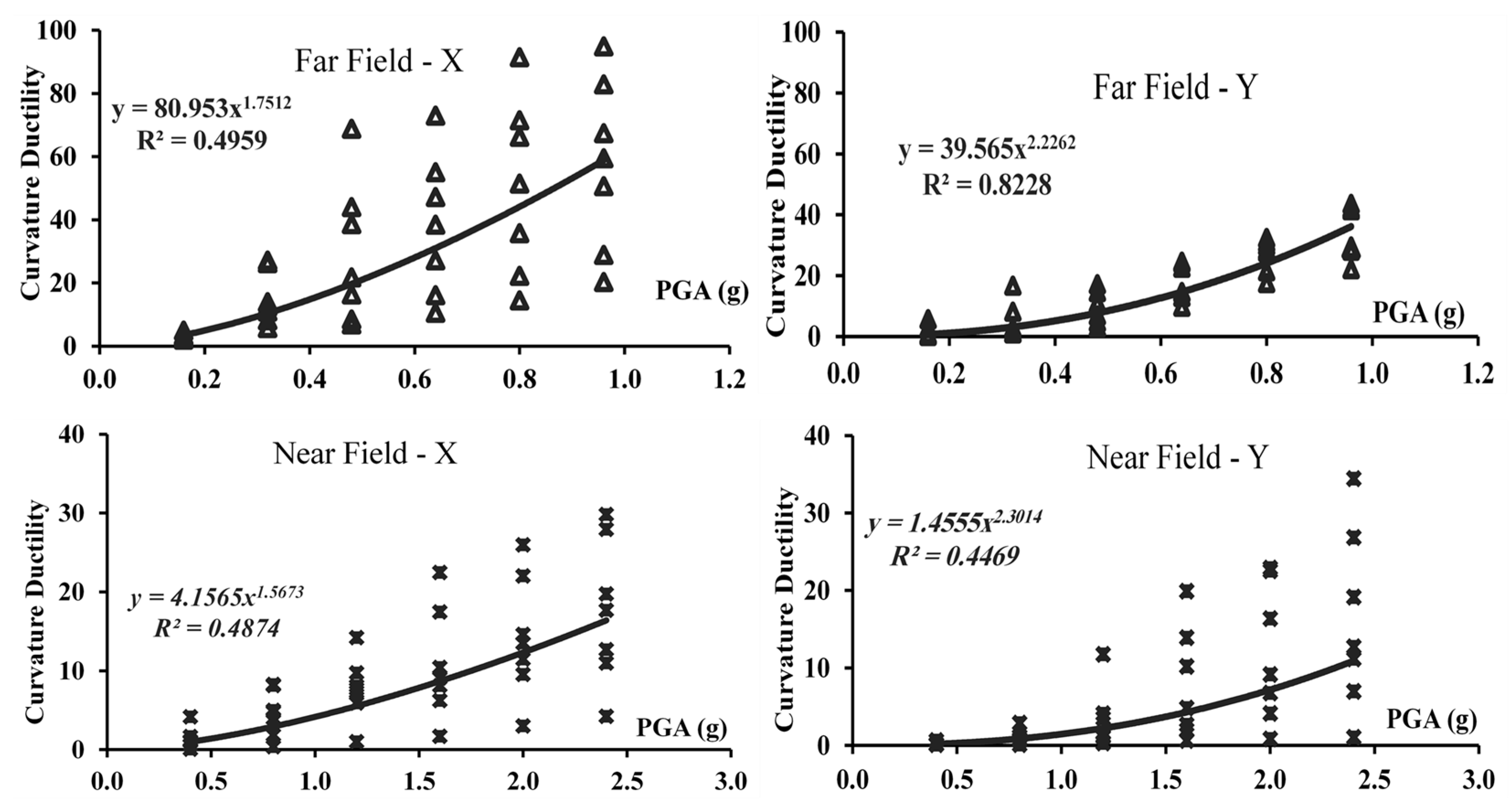
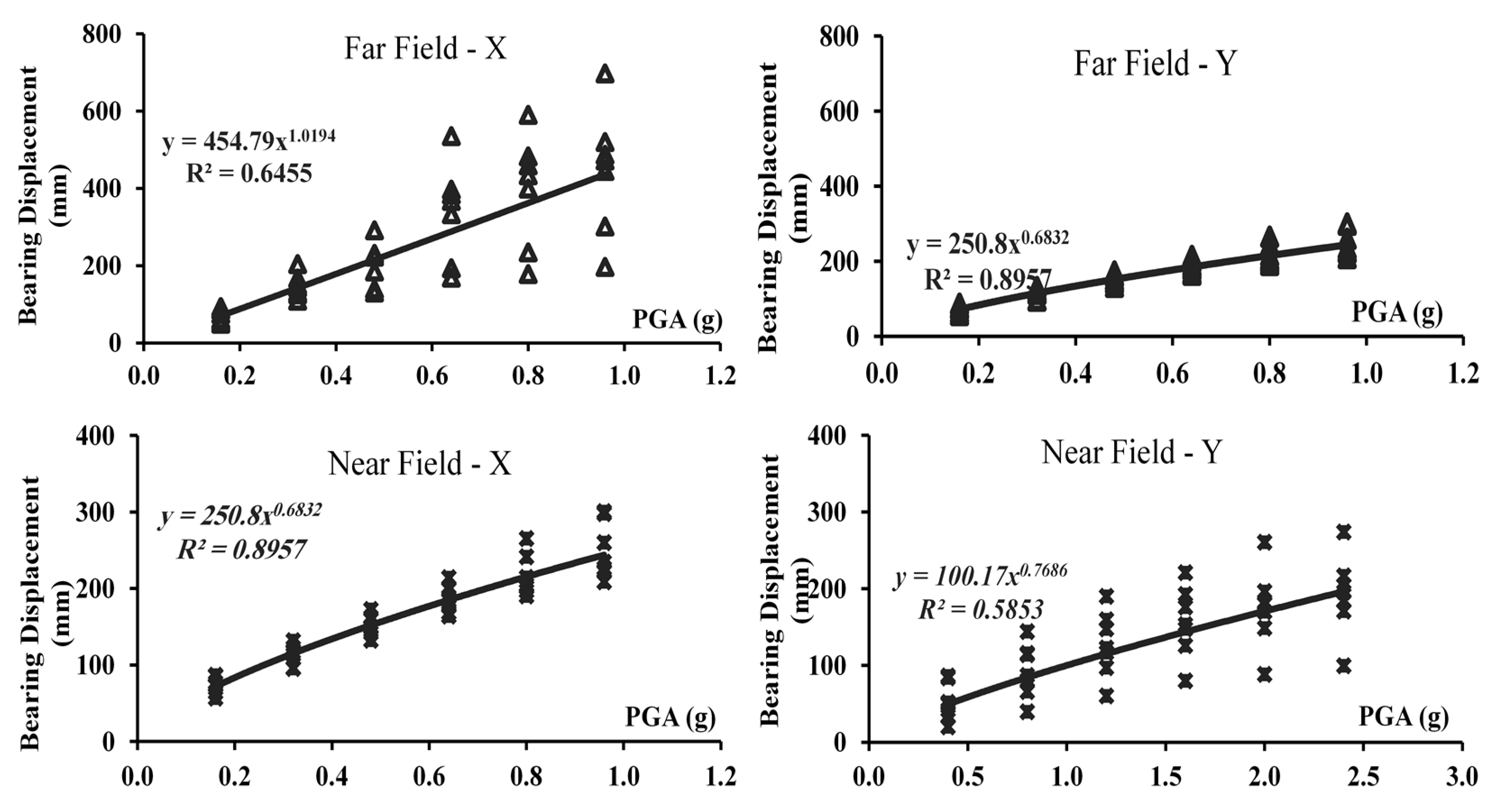
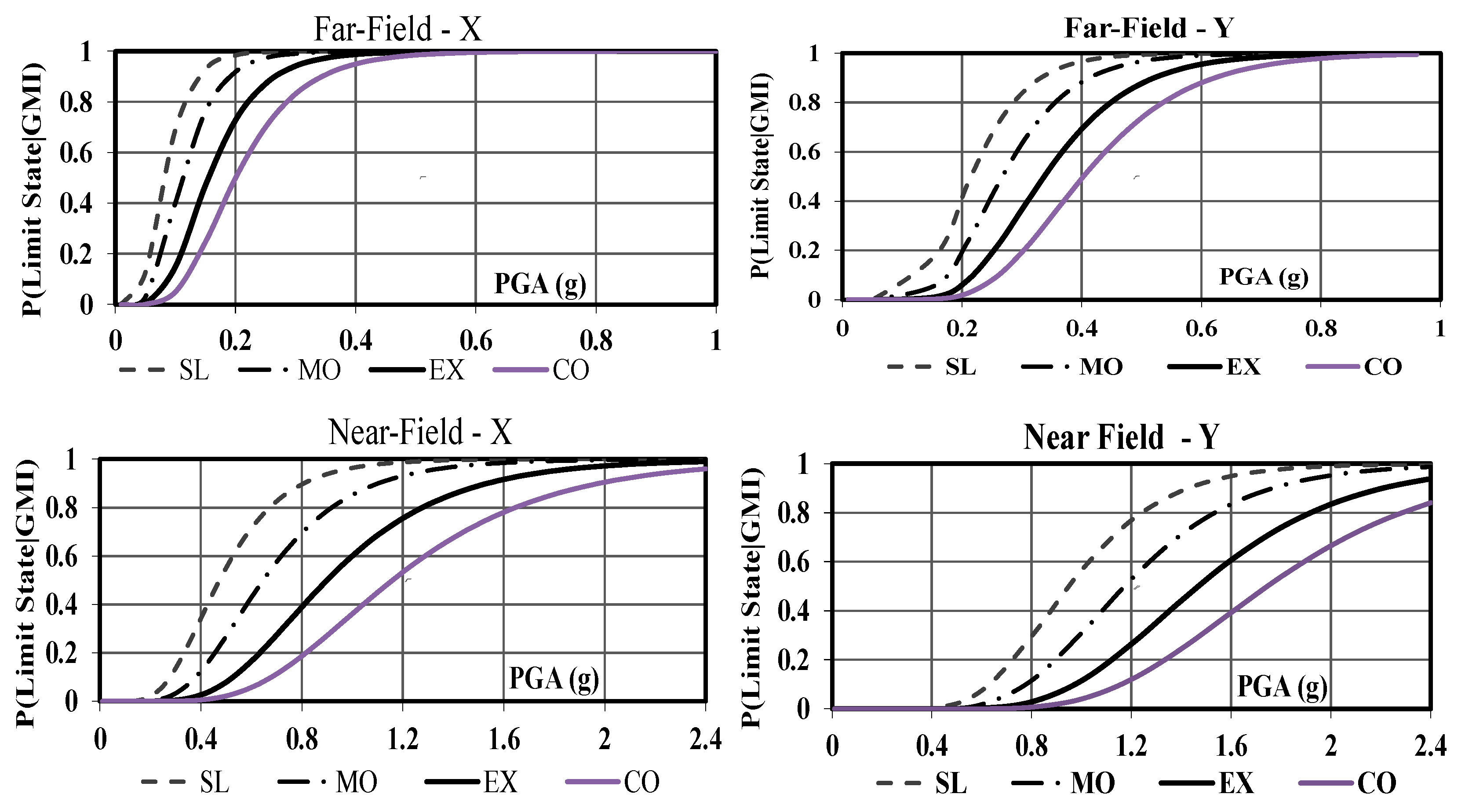
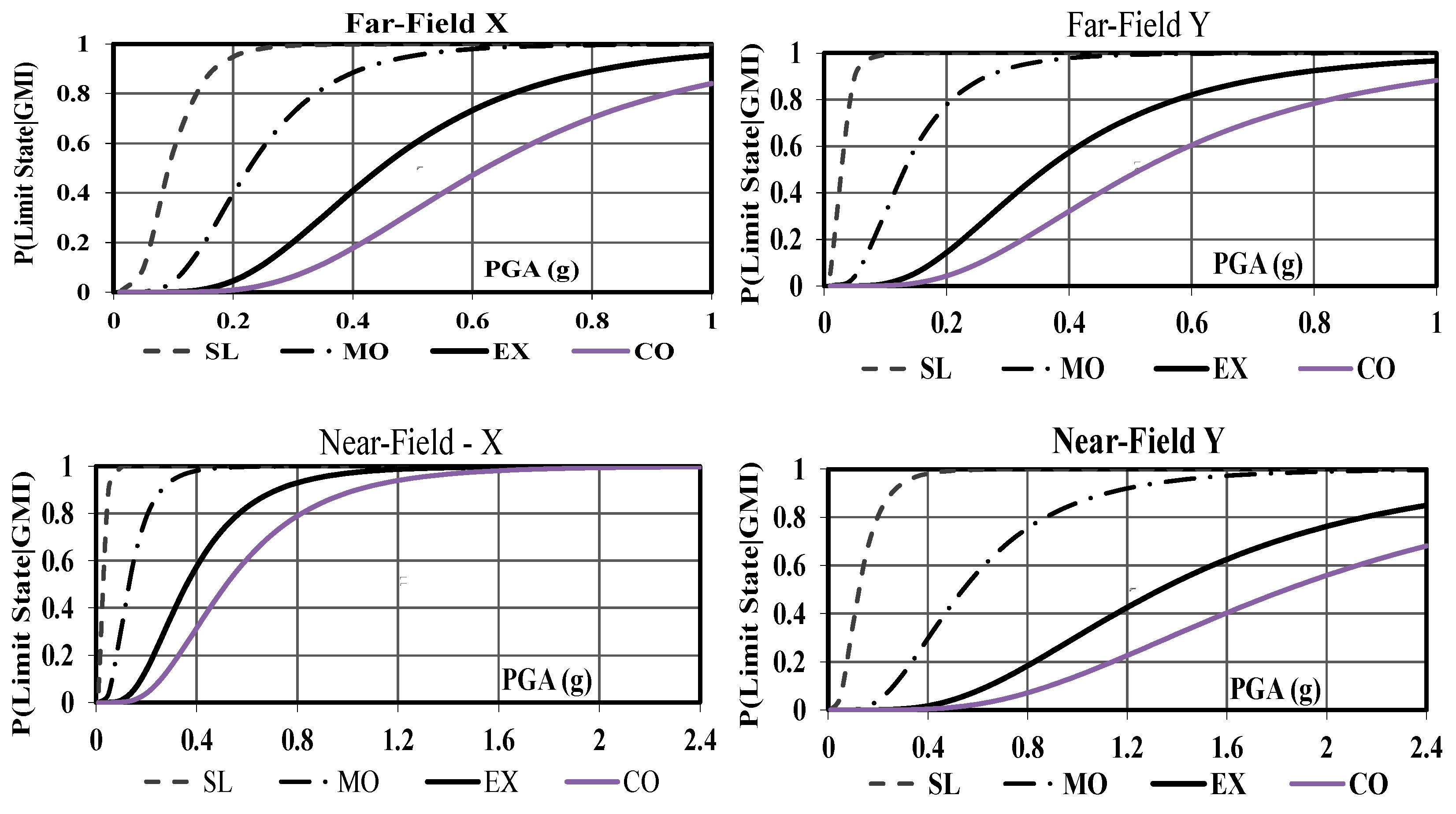

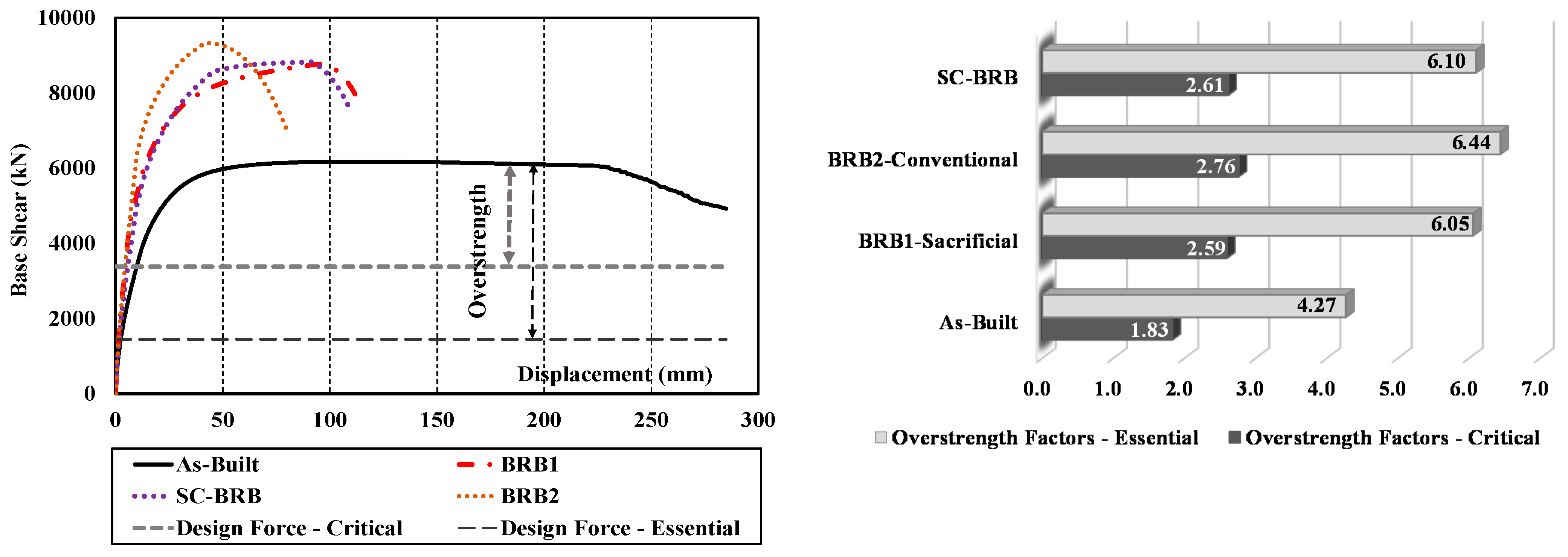


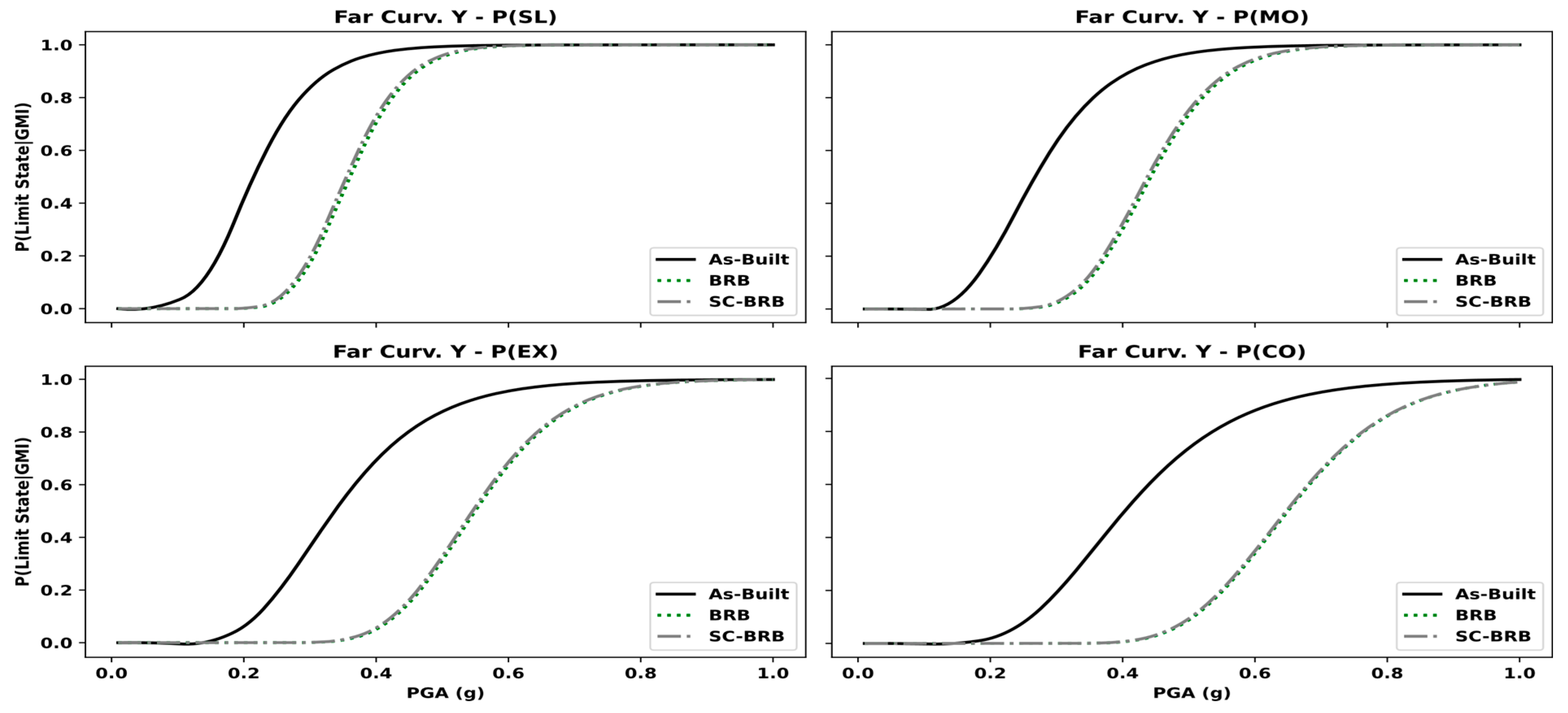

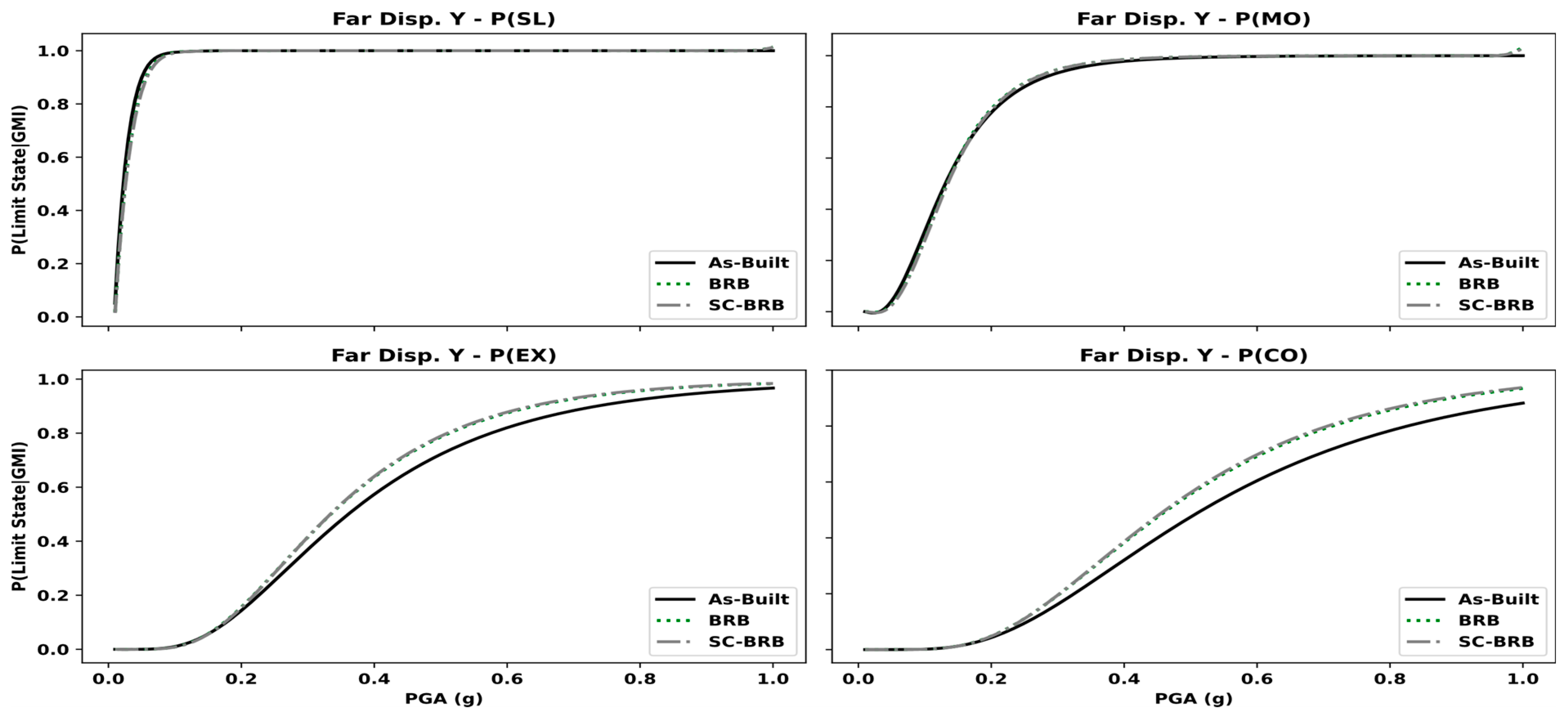
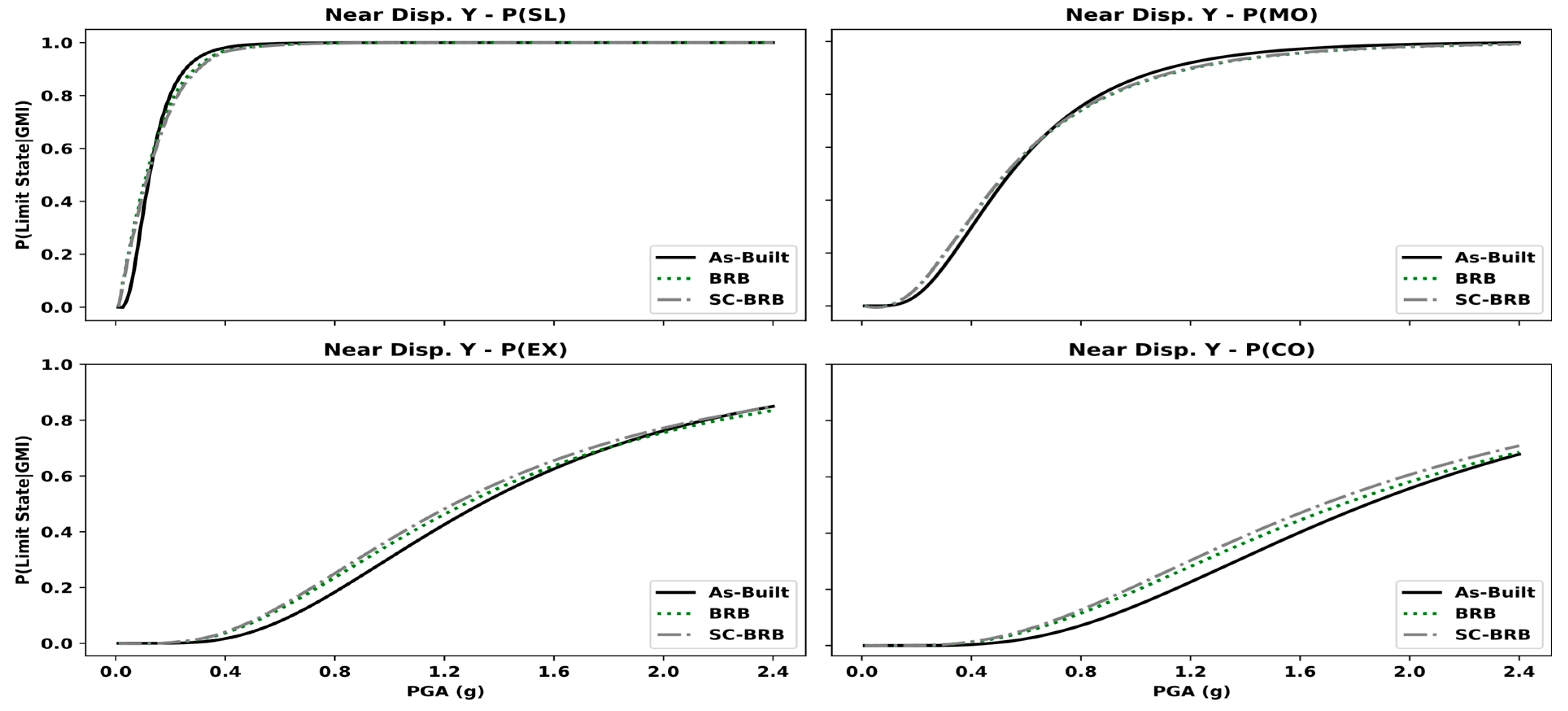


Publisher’s Note: MDPI stays neutral with regard to jurisdictional claims in published maps and institutional affiliations. |
© 2022 by the authors. Licensee MDPI, Basel, Switzerland. This article is an open access article distributed under the terms and conditions of the Creative Commons Attribution (CC BY) license (https://creativecommons.org/licenses/by/4.0/).
Share and Cite
Ghazal, H.; Mwafy, A. Seismic Fragility Assessment of an Existing Multi-Span RC Bridge Equipped with Risk Mitigation Systems. Buildings 2022, 12, 982. https://doi.org/10.3390/buildings12070982
Ghazal H, Mwafy A. Seismic Fragility Assessment of an Existing Multi-Span RC Bridge Equipped with Risk Mitigation Systems. Buildings. 2022; 12(7):982. https://doi.org/10.3390/buildings12070982
Chicago/Turabian StyleGhazal, Homam, and Aman Mwafy. 2022. "Seismic Fragility Assessment of an Existing Multi-Span RC Bridge Equipped with Risk Mitigation Systems" Buildings 12, no. 7: 982. https://doi.org/10.3390/buildings12070982
APA StyleGhazal, H., & Mwafy, A. (2022). Seismic Fragility Assessment of an Existing Multi-Span RC Bridge Equipped with Risk Mitigation Systems. Buildings, 12(7), 982. https://doi.org/10.3390/buildings12070982






